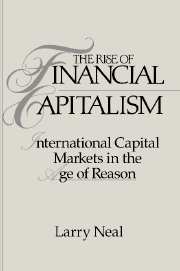Book contents
- Frontmatter
- Contents
- Acknowledgments
- 1 Historical background for the rise of financial capitalism: commercial revolution, rise of nation-states, and capital markets
- 2 The development of an information network and the international capital market of London and Amsterdam
- 3 The early capital markets of London and Amsterdam
- 4 The Banque Royale and the South Sea Company: how the bubbles began
- 5 The Bank of England and the South Sea Company: how the bubbles ended
- 6 The English and Dutch East Indies companies: how the East was won
- 7 The integration of the English and Dutch capital markets in peace and war
- 8 The English and Dutch capital markets in panics
- 9 The capital markets during revolutions, war, and peace
- 10 A tale of two revolutions: international capital flows, 1792–1815
- 11 The Amsterdam and London stock markets, 1800–25
- Appendix End-of-month share prices
- Bibliography
- Index
2 - The development of an information network and the international capital market of London and Amsterdam
Published online by Cambridge University Press: 25 March 2010
- Frontmatter
- Contents
- Acknowledgments
- 1 Historical background for the rise of financial capitalism: commercial revolution, rise of nation-states, and capital markets
- 2 The development of an information network and the international capital market of London and Amsterdam
- 3 The early capital markets of London and Amsterdam
- 4 The Banque Royale and the South Sea Company: how the bubbles began
- 5 The Bank of England and the South Sea Company: how the bubbles ended
- 6 The English and Dutch East Indies companies: how the East was won
- 7 The integration of the English and Dutch capital markets in peace and war
- 8 The English and Dutch capital markets in panics
- 9 The capital markets during revolutions, war, and peace
- 10 A tale of two revolutions: international capital flows, 1792–1815
- 11 The Amsterdam and London stock markets, 1800–25
- Appendix End-of-month share prices
- Bibliography
- Index
Summary
The religious and dynastic wars that convulsed Europe in the quarter century 1688–1713 were fought on a larger scale than the earlier wars of the seventeenth century, and arguably with less result. Moreover, in the course of the War of the League of Augsburg (1689–97) and the War of the Spanish Succession (1702–13), communities of religious and political minorities, not to mention deposed dynastic households, were dispersed in greater numbers than ever before. These dispersed communities kept in touch with one another through regular correspondence, facilitated during wartime by the movements of troops and supplies for those troops and during peacetime by the packet boats and stagecoaches that were regularly carrying post among the ports and capital cities of Europe.
The emerging network of information in Europe in the seventeenth century centered on Amsterdam. The various reasons for this were well analyzed by Woodruff Smith, who focused on the reporting innovations made by the Dutch East India Company in order to maintain central control of its far-flung operations. From this invaluable internal source of information were derived the linkages to merchants dealing with the Dutch East India Company and even to the rival English and French companies and to the governments of all the European powers. As more merchants, consular agents, and newspaper publishers congregated at Amsterdam, the amount of information available increased, and the bits of information being exchanged increased geometrically. Amsterdam's natural monopoly as an information center was confirmed.
London, however, grew rapidly in importance both as a commercial center and as an information center.
- Type
- Chapter
- Information
- The Rise of Financial CapitalismInternational Capital Markets in the Age of Reason, pp. 20 - 43Publisher: Cambridge University PressPrint publication year: 1991



